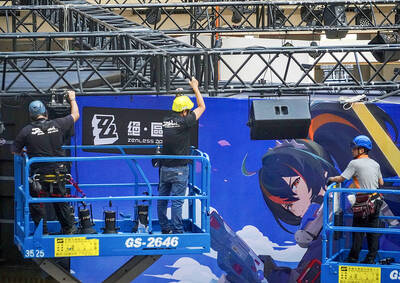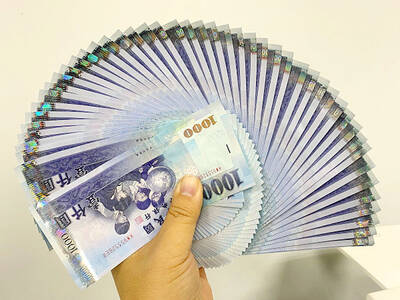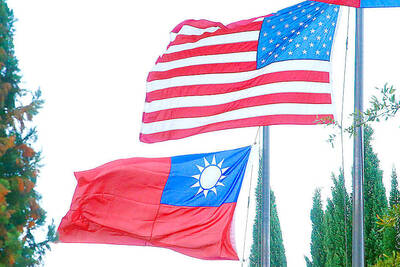Never mind the sports. The real battle in Beijing is not the struggle to top the medal table, but the multibillion-dollar fight between two giant brands intent on conquering the fastest-growing sportswear market in the world.
Adidas and Nike have invested unprecedented sums in wooing Chinese consumers during the Olympics. The German firm is estimated to have spent US$190 million on sponsorship and associated marketing; its US rival has stumped up close to US$150 million.
Adidas is sponsoring the Games, as well as the Chinese Olympic committee. Torchbearers, officials and volunteers are all clad in the brand; so too are Chinese champions.
“Every single Chinese athlete winning a medal will be in Adidas on the podium,” said Paul Pi (畢寶元), vice-president of marketing for Adidas China.
But Nike has fought back by sponsoring the Chinese teams in 22 of 28 Olympic sports.
At the root of this rivalry is a market a fraction the size of that of the US — but growing at 30 percent annually for the past five years.
“If you want to lead globally, you have to lead in China,” Pi said.
Nike says it passed the US$1 billion sales mark this spring, a year ahead of schedule. Adidas says it has leapfrogged its rival in becoming market leader by the start of the Games, with sales up 60 percent in the first half of this year — though its claim is based on factors such as brand image. It is “on course” to reach US$1.5 billion by 2010.
“They are absolutely neck and neck,” Terry Rhoads of Shanghai-based sports specialists Zou Marketing said.
“Adidas had to have this sponsorship,” said Greg Paull, co-founder of marketing consultants R3, who believes the brand was at risk because of Nike’s deals with individual athletes.
“We expected the Olympics would not be a powerful marketing tool — but the opposite has been the case. The market hasn’t matured to the stage of the US or UK in terms of marketing literacy and the celebrity aspect is still very strong,” he said.
Adidas has tapped into the national passion for sport with a campaign that gives its standard slogan a patriotic twist: “Together in 2008 — Impossible is nothing.”
“Other countries are interested in the Olympics. But in China well over 90 percent of people are passionate and supportive and want to be involved,” Pi said.
Meanwhile, Nike’s “Courage” advertising spots emphasize individual achievement.
“For us, it’s about connecting with athletes: We make products that make them perform better and then build on the excitement that creates,” said Nike spokesman Charlie Brookes, citing the ultralight Hyperdunk shoe for Kobe Bryant or Asafa Powell’s Zoom Aerofly.
The real race is outside the Olympic zone. Adidas, which is opening stores at the rate of two a day, will have 5,000 shops in China by the end of the year. Its new store in Sanlitun — several kilometers away from the Bird’s Nest stadium — opened last month and is the largest in the world, with 3,170m² of retail space over four floors. There is a rooftop basketball court, a smoothie bar, computer terminals to customize trainers and exercise stations. A gallery showcases the footwear Adidas has made for the Games, from boxing boots to slides for divers — all presented in glass cases and lit with artistic reverence.
Nike has slightly fewer outlets, and its flagship store is a mere 1,208m², but its Wangfujing location is one of Beijing’s premier shopping hubs. It also boasts a gallery in the 798 art district, where the current exhibition traces the brand’s development — and not a single item is for sale.
Meanwhile, the two companies face competition from sporting icon turned entrepreneur Li Ning (李寧). The three-time gold medalist demonstrated his gymnastic flair as he “ran” around the top of the Bird’s Nest Stadium before lighting the Olympic cauldron — albeit dressed in Adidas. But to many young Chinese people he is now as well known for his eponymous sportswear brand: sales reached US$750 billion last year. After his appearance, his Hong Kong-listed stock rose 3.5 percent.

Taiwan is projected to lose a working-age population of about 6.67 million people in two waves of retirement in the coming years, as the nation confronts accelerating demographic decline and a shortage of younger workers to take their place, the Ministry of the Interior said. Taiwan experienced its largest baby boom between 1958 and 1966, when the population grew by 3.78 million, followed by a second surge of 2.89 million between 1976 and 1982, ministry data showed. In 2023, the first of those baby boom generations — those born in the late 1950s and early 1960s — began to enter retirement, triggering

ECONOMIC BOOST: Should the more than 23 million people eligible for the NT$10,000 handouts spend them the same way as in 2023, GDP could rise 0.5 percent, an official said Universal cash handouts of NT$10,000 (US$330) are to be disbursed late next month at the earliest — including to permanent residents and foreign residents married to Taiwanese — pending legislative approval, the Ministry of Finance said yesterday. The Executive Yuan yesterday approved the Special Act for Strengthening Economic, Social and National Security Resilience in Response to International Circumstances (因應國際情勢強化經濟社會及民生國安韌性特別條例). The NT$550 billion special budget includes NT$236 billion for the cash handouts, plus an additional NT$20 billion set aside as reserve funds, expected to be used to support industries. Handouts might begin one month after the bill is promulgated and would be completed within

The National Development Council (NDC) yesterday unveiled details of new regulations that ease restrictions on foreigners working or living in Taiwan, as part of a bid to attract skilled workers from abroad. The regulations, which could go into effect in the first quarter of next year, stem from amendments to the Act for the Recruitment and Employment of Foreign Professionals (外國專業人才延攬及僱用法) passed by lawmakers on Aug. 29. Students categorized as “overseas compatriots” would be allowed to stay and work in Taiwan in the two years after their graduation without obtaining additional permits, doing away with the evaluation process that is currently required,

NO CHANGE: The TRA makes clear that the US does not consider the status of Taiwan to have been determined by WWII-era documents, a former AIT deputy director said The American Institute in Taiwan’s (AIT) comments that World War-II era documents do not determine Taiwan’s political status accurately conveyed the US’ stance, the US Department of State said. An AIT spokesperson on Saturday said that a Chinese official mischaracterized World War II-era documents as stating that Taiwan was ceded to the China. The remarks from the US’ de facto embassy in Taiwan drew criticism from the Ma Ying-jeou Foundation, whose director said the comments put Taiwan in danger. The Chinese-language United Daily News yesterday reported that a US State Department spokesperson confirmed the AIT’s position. They added that the US would continue to